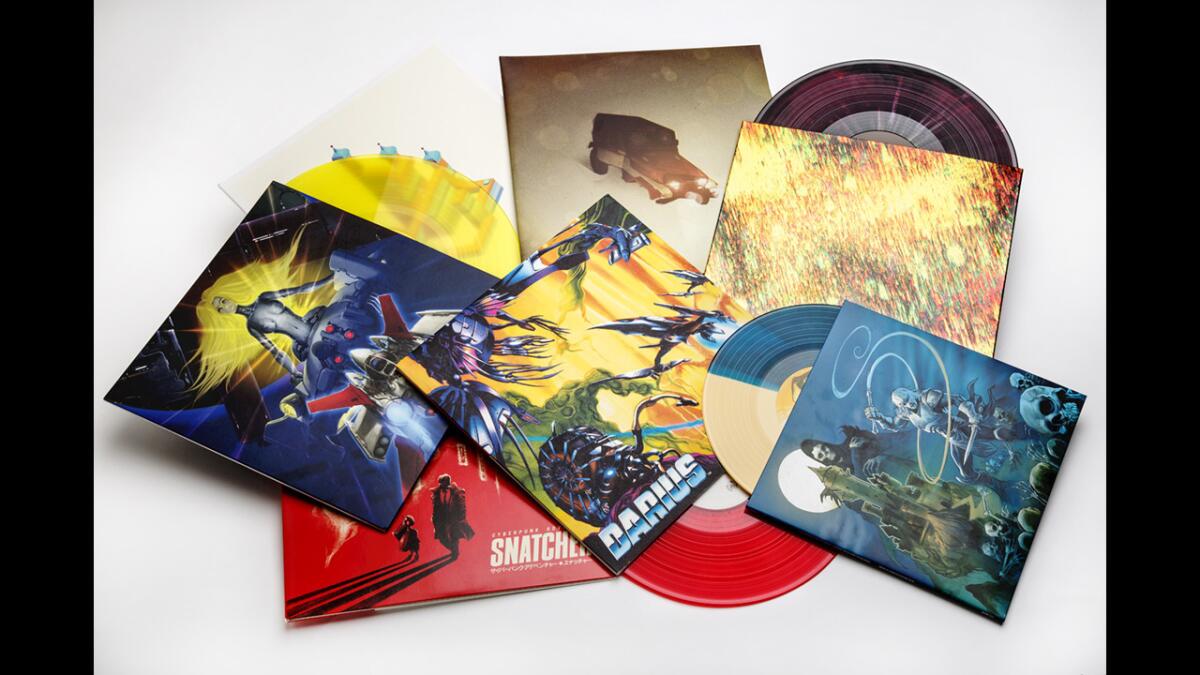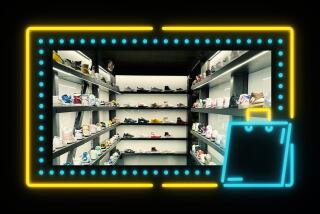The latest and greatest trend in vintage vinyl? Video game music

The pursuit of rare, unreleased music has carried record geeks and reissue labels to every corner of the globe, from dusty attics to spider-webbed basements.
What used to be called “digging in the crates” for unheralded sounds, however, has recently shifted to less tangible realms, as archivists, devoted fans and boutique vinyl labels such as Ship to Shore PhonoCo., Data Discs and the L.A.-based Iam8bit aim their flashlights at more virtual worlds.
By transferring vintage video game scores onto long-playing records with deluxe packaging, multi-colored vinyl, original artwork and, most important, high-quality remastered recordings, music originally composed to propel action is finding life outside the coding.
Jon Gibson, co-owner of Iam8bit, a pioneer in the space, notes the movement stresses “the notion that games are more than just the assembly of all the different parts. They can be dissected. You can appreciate game art. You can appreciate game music, and design, and characters and story. It’s all a cross-section that meets in the middle.”
There’s more than just nostalgia at play.
Today video game scores aren’t too dissimilar from their counterparts in more established media, bringing some long overdue musical respect to the interactive space. Michael Giacchino, whose recent credits include “Zootopia” and “Rogue One,” established himself in the game arena, and the ambient-meets-orchestral work of Austin Wintory on “Journey” even earned a Grammy nomination.
When Jamie Crook helped open the London-based label Data Discs, which since 2015 has specialized in video game soundtracks, he says he had a hunch that there was a market, “but I don’t think we were quite prepared for how passionate the fan base is. This music has quite a lot of meaning to people.”
Through a relationship with the Japanese gaming company Sega, Data Discs has issued 10 game soundtracks in the last few years and six more are in various stages of production. “It is really mind-boggling stuff,” says Crook of the music, “and it’s a shame for that to be locked away in a 30-year-old game for the rest of time. It deserves to be appreciated on its own merits.”
That this appreciation is occurring on vinyl and not compact disc shouldn’t be surprising. The medium, nearly extinct by the mid-’00s, has seen a resurgence across demographics. In 2016, vinyl marked its 11th consecutive year of sales growth. According to Nielsen Music, consumers bought more than 13 million records.
Still, video game scores make up a tiny fraction of that. Most specialty labels press between 500 and 5,000 copies of each title, many of which are limited runs.
The music is adventurous. An in-demand collector’s edition vinyl soundtrack to “Hotline Miami 2,” which was issued by Iam8bit, is a trippy, dreamy mix of retro pop and modern electronics. The Echo Park gallery and store also released the LP for “Ori and the Blind Forest,” a meditative blend of wistful strings and sparse orchestration.
The bouncy 8-bit music for “Castlevania II: Simon’s Quest,” recently issued by Austin-based label Mondo, might sound quaint when heard through a TV speaker, but on a good stereo the music moves with Wagnerian gusto.
Another boutique imprint, Ship to Shore, booted up its business through Kickstarter. Founded as a soundtrack label by two former employees of low-budget film production company Troma Entertainment, the company launched a $42,000 fundraising campaign to press a limited edition of the soundtrack to “Mother,” a 1989 Japanese role-playing game published by Nintendo. Ship to Shore exceeded that goal in a few days, ultimately tallying $75,000.
“After the great response to that I thought, ‘Well there’s clearly something here. People want this,’” said Brooklyn-based Ship to Shore co-founder Aaron Hamel.
But why vintage game music? Old video game scores, after all, were confined by the limitations of technology. Graphics and interactivity were said to be prioritized over musical accompaniment, and early scores had to be composed line by line in computer code. The resultant music, dubbed “chiptunes” by fans, captures a moment in time.
Crook said that when he first pitched the idea to the Japanese game company Sega, he was greeted with “many layers of confusion. ‘People listen to records? Do people still do that?’ And beyond those standard questions you have, ‘Why would people want to listen to a game soundtrack?’”
The answer, according to Crook: “There were a lot of people who were already treating [the music] on its own merits.” He heard stories, he said, of fans who used to record game music onto their old Sony Walkmans to enjoy when not playing.
Data Discs’ first release was for the Sega Genesis game “Streets of Rage.” The score, which was composed by Yuzo Koshiro, illustrates the sophistication required to tap the circuitry.
“It’s just binary code, basically,” explains Crook of Koshiro’s creation. But when played through the Sega console, the composer exploited the medium’s weaknesses in service of the score: “Running it through the chip alters the sound, but he was programming in ways to compensate for that — and was using the noise of the chip itself for melodies and different layers.”
Whether the enthusiasts are aging gamers yearning for sounds of their youth or music geeks exploring unknown sonic realms, the unlikely jump from virtual to physical has filled a longing, says Amanda White, co-owner with Gibson of Iam8bit.
The company has built a whole enterprise around bringing heft to the intangible. In addition to vinyl, the company sells apparel, books and ephemera for the digitally drawn, and runs a successful production company and art gallery on Sunset Boulevard.
“While we work in this world that is virtual and digital, we both see a really vital need for human beings to have a connection to tangible objects — which is why we started this endeavor of making things that people can touch or hold in your hands,” says White.
Gibson added, “A Disney song from ‘Aladdin’ or ‘The Little Mermaid’ or ‘Beauty and the Beast’ — those songs resonate outside of the context of the movie. The same thing happens with games. It’s just a matter of it being a slightly more difficult prospect for people to understand.”
For tips, records, snapshots and stories on Los Angeles music culture, follow Randall Roberts on Twitter and Instagram: @liledit. Email: [email protected].
ALSO:
L.A. punk band X to get 40th-anniversary exhibit at the Grammy Museum
Op-Ed: Why is vinyl making a comeback? ‘Nostalgia’ doesn’t quite cut it
Opinion: Digital vs. analog: Vinyl is making a comeback, but is it actually better?
More to Read
The biggest entertainment stories
Get our big stories about Hollywood, film, television, music, arts, culture and more right in your inbox as soon as they publish.
You may occasionally receive promotional content from the Los Angeles Times.











